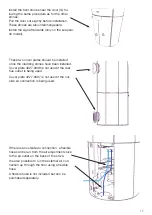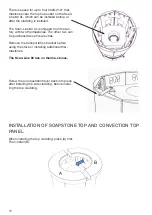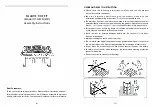
7
oPerational ProBleMs
The chimney must be swept at least once a year,
we recommend the use of a NACS (national as-
sociation of chimney sweeps) registered chim-
ney sweep. In the event of smoke or malodo-
rous fumes being produced, you must first
check to see whether the chimney is blocked.
The chimney must, of course, always provide
the minimum draught necessary to ensure that
it is possible to regulate the fire. Please note,
however, that chimney draft is dependent on the
weather conditions. In high winds, the draft can
become so powerful that it may be necessary
to fit a damper in the flue gas pipe to regulate
the draft. When cleaning the chimney, soot and
other deposits may come to fall on the smoke
turning plate. In cases where the wood burns
too quickly, this may be due to excessive chim-
ney draught. You should also check to make
sure that the door seal is intact and correctly
fitting.
If the stove it generating too little heat, this may
be because you are firing with wet wood. In this
case, much of the heating energy is used to dry
the wood, resulting in poor heating economics
and an increased risk of soot deposits in the
chimney.
Check whether the air holes in the stones are
blocked with for example ashes etc. Below the
casted shaking grate is it possible to clean the
air channel for the start-up airflow.
MaintenanCe
The surface of the stove has been treated with
heat-resistant paint.
The stove should be cleaned with a damp cloth.
Any damage to the surface in the form of chips
or scratches can be repaired using touch-up
paint, which is available in spray cans.
Cleaning the glass
Incorrect firing, for example using wet wood,
can result in the viewing window becoming co-
vered in soot. This soot can be easily and effec-
tively removed by using proprietary stove glass
cleaner.
Cleaning and repairing
soapstone surfaces
Soapstone is a relatively soft natural product.
It is therefore possible to repair scratches or
other damage to the surface.
Cleaning soapstone surfaces
Clean soot, grease, etc. from surfaces using
water and soft soap or similar.
- Spread the soap on the surface
- Let it stand a few minutes
- Rinse off the surface using hot water
- Once the surface is dry you can sand it gently
if necessary using sandpaper (120 grit)
Minor scratches and impact marks
Gently sand using sandpaper (120 grit) until the
scratches are gone. It is a good idea to use a
sanding block. To maintain a uniform surface on
the stone, the entire surface should be gently
sanded at the end.
Chipped surfaces
This section covers more serious damage, such
as if a piece has chipped off or is missing. If the
chipped off piece is intact, it can be glued in
place using ’waterglass’ (available from Heta
A/S). Apply waterglass to the surfaces, clamp in
place for 24 hours, then sand using sandpaper
(120 grit). If a piece is missing or an impact mark
is deep, you can repair the damage using a mix
of soapstone powder and waterglass (available
from Heta A/S). Mix the powder and waterglass
to an appropriate consistency. Clean off any
dust before applying the mixture. Brush the sur-
face with waterglass to ensure good adhesion.
Apply the soapstone mixture generously, as it
contracts during hardening. Do a repeat appli-
cation if necessary. The hardened surface can
be sanded after 24 hours. Use 60-80 grit sand-
paper initially, and then 120 grit sandpaper to
finish.
Cleaning ceramic surfaces
The ceramics have a glazed surface and can be
wiped with a damp cloth.
Summary of Contents for SCAN-LINE 80
Page 14: ...14...






































